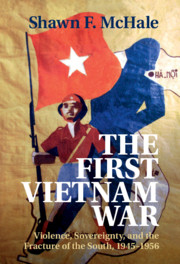Book contents
- The First Vietnam War
- The First Vietnam War
- Copyright page
- Contents
- Figures
- Tables
- Acknowledgments
- Abbreviations
- Introduction: Sovereignty, Violence, and Institutional Collapse at the Edge of France’s Empire
- Part I Fracture, 1945–1947
- 1 A Plural Mekong Delta under Stress
- 2 The Southern General Uprising
- 3 Priming Upheavals in the Mekong Delta
- 4 The Double Fracture of the Mekong Delta
- Part II Disassemblage/Reassemblage, 1947–1953
- Part III Endgame, 1953–1956
- Bibliography
- Index
2 - The Southern General Uprising
from Part I - Fracture, 1945–1947
Published online by Cambridge University Press: 17 August 2021
- The First Vietnam War
- The First Vietnam War
- Copyright page
- Contents
- Figures
- Tables
- Acknowledgments
- Abbreviations
- Introduction: Sovereignty, Violence, and Institutional Collapse at the Edge of France’s Empire
- Part I Fracture, 1945–1947
- 1 A Plural Mekong Delta under Stress
- 2 The Southern General Uprising
- 3 Priming Upheavals in the Mekong Delta
- 4 The Double Fracture of the Mekong Delta
- Part II Disassemblage/Reassemblage, 1947–1953
- Part III Endgame, 1953–1956
- Bibliography
- Index
Summary
This chapter presents a novel interpretation of the August General Uprising of 1945, often known as the "August Revolution," its precursors, and its immediate impacts. The dominant interpretation of this "revolution" emphasizes the leading role of the Indochinese Communist Party at the head of the Viet Minh and sees the northern "model" of uprising established in Hanoi as the template for the "revolution" as a whole. The South, and Saigon in particular, ill fit this model. The chapter discusses the precursor to the August Uprisings: the slow collapse of the economy, the Japanese overthrow of the French regime on March 9, 1945, the end of World War II, and the surrender of the Japanese in August 1945. At this point, Instead, multiple actors, including communists (both "Stalinists" and Trotskyists), nationalists, and religious groups like the Cao Dai and the Buddhist Hoa Hao, engaged in parallel but intersecting mobilizations to seize power, which ultimately occurred under the Viet Minh banner. The chapter discusses the rampant violence under no centralized control, the arrival of the British forces temporarily occupying the city under the Allies, the French arrival in September, and the Vietnamese declaration of Resistance War in September 1945.
- Type
- Chapter
- Information
- The First Vietnam WarViolence, Sovereignty, and the Fracture of the South, 1945–1956, pp. 37 - 64Publisher: Cambridge University PressPrint publication year: 2021

